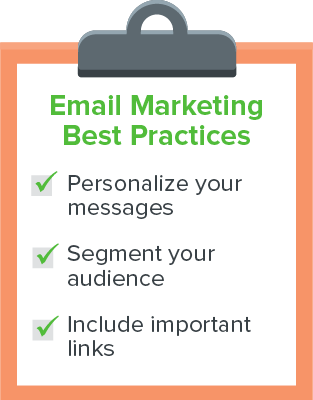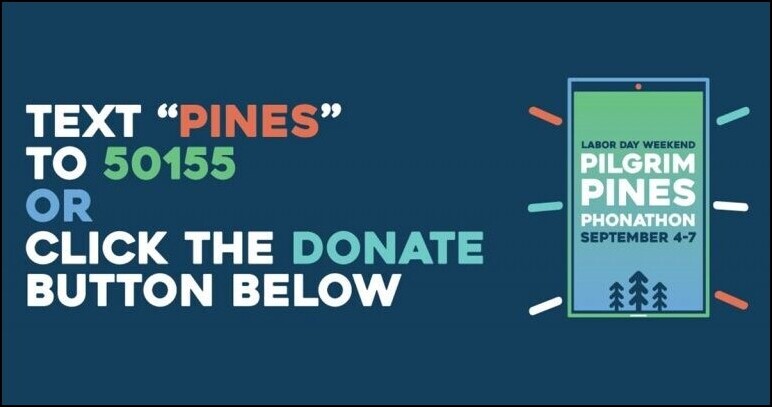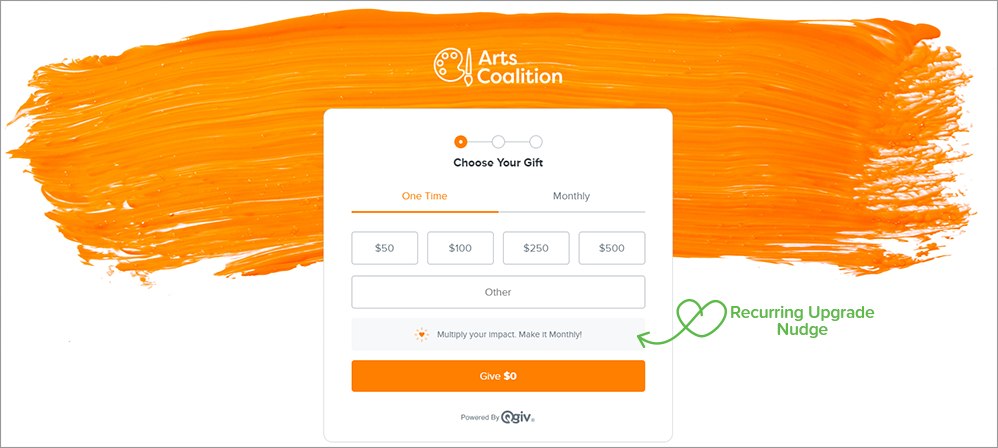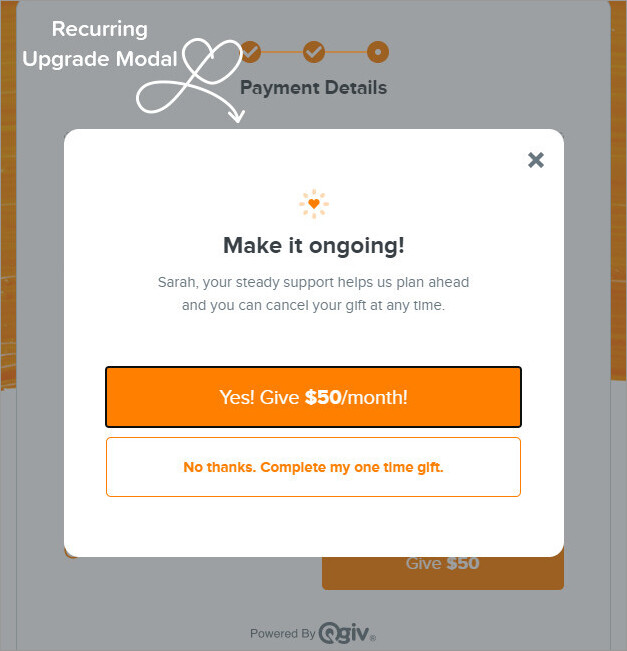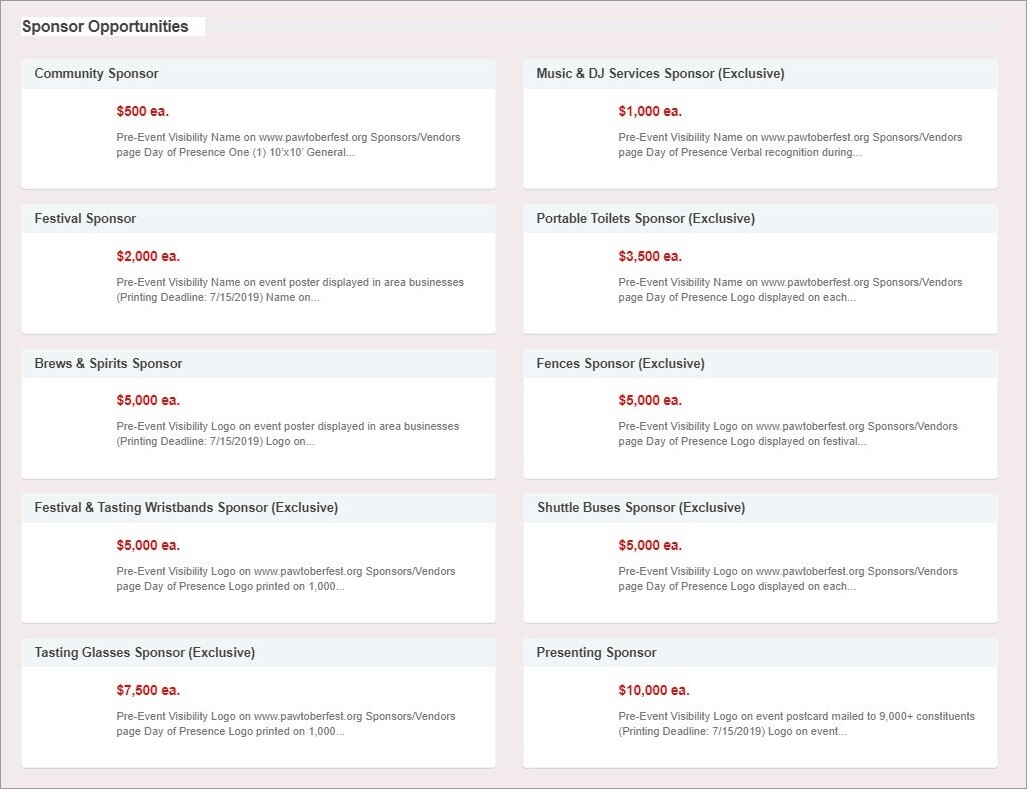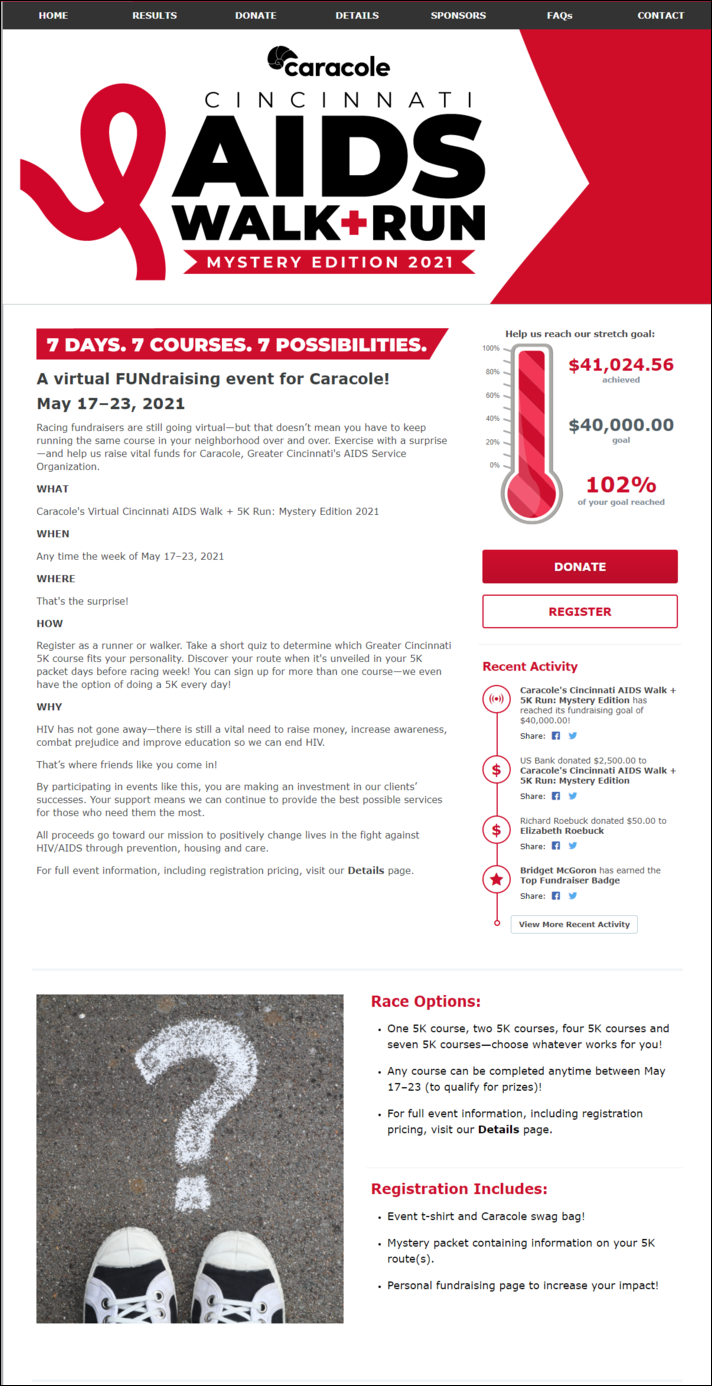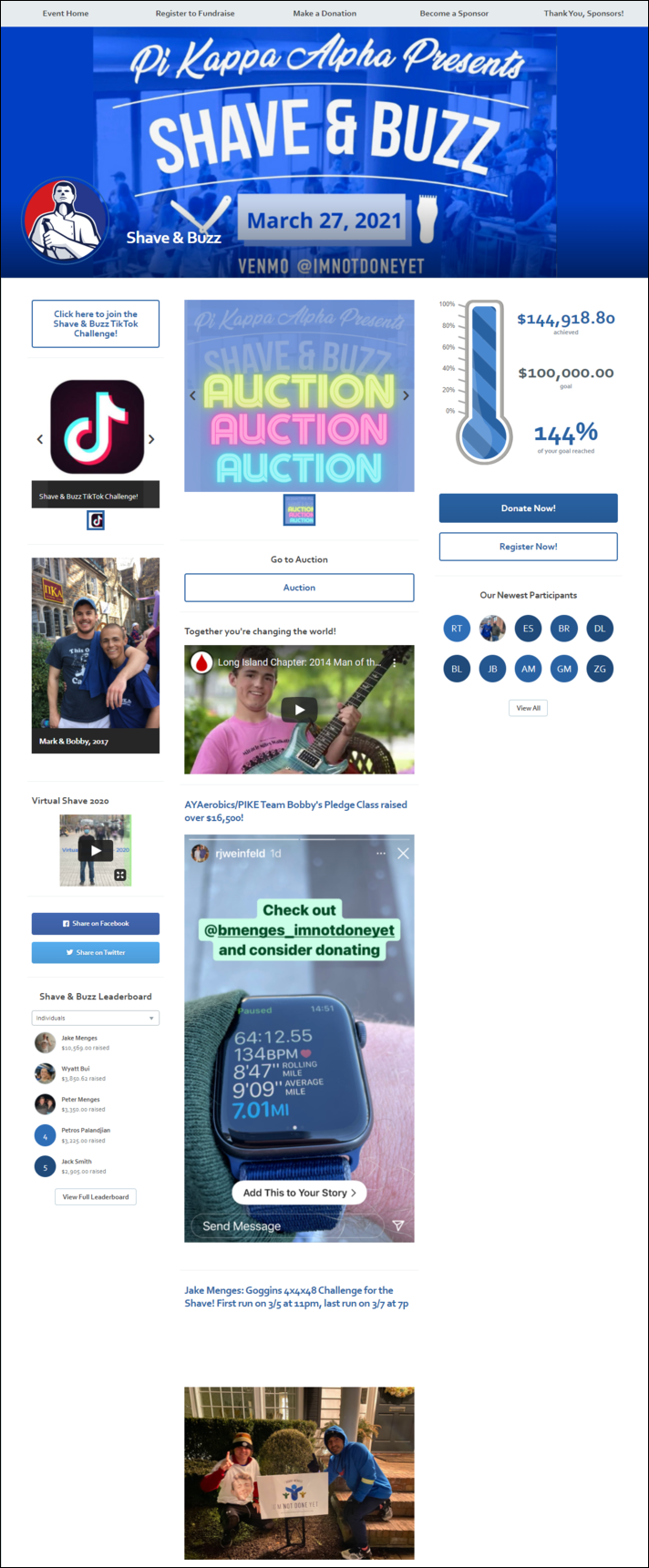Donations are essential to the health of your nonprofit organization. Without the generosity of your current donors and your consistent effort to acquire new ones, it would be impossible for your team to continue working toward accomplishing your mission.
However, collecting donations is easier said than done, whether you’re a small nonprofit just starting out or a large, well-established organization.
We also have some good news for you. According to our fundraising statistics, charitable giving is expected to increase by 5.1% in 2021. What does this mean for your organization? Despite the recent challenges of the COVID-19 pandemic, people are still ready and willing to give to the causes they feel strongly about. You just need some fresh strategies so you know how to get donations for your cause.
Here at Qgiv, we’re invested in helping you raise more money, and we know how difficult it can be. In addition to offering easy-to-use fundraising tools, we’ve also come up with these tips for supercharging your fundraising efforts:
- Use your data.
- Improve your existing donation form.
- Update your website.
- Make sure everything is mobile-responsive.
- Use consistent branding.
- Optimize your email strategy.
- Leverage text fundraising.
- Don’t forget about direct mail!
- Use social media.
- Consider other media outreach.
- Plan exciting fundraising events.
- Conduct peer-to-peer fundraising.
- Encourage recurring donations.
- Up your storytelling game.
- Find more major gifts.
- Look for grants.
- Invest in paid search.
- Ask your donors to spread the word.
- Set up a fundraising store.
- Reach out to potential sponsors.
- Connect with volunteers.
- Get creative!
Ready to increase your fundraising potential by following these tips? Let’s dive right in!
See how Qgiv can help you with your fundraising campaign! Request Demo
20+ Tips to Get More Donations
As you read through these tips, be thoughtful in selecting the strategies that will work well for your nonprofit. Not every fundraising strategy is one-size-fits-all, and you know your donors best!
1. Use your data.
When a donor gives to your organization, you likely collect a good amount of information in your CRM, including their name, contact information, and address. You might also get extra information, depending on what your donation form asks for. Some nonprofits like to include optional questions on their form to find out how donors found out about the organization or how they prefer to be contacted.
When you use your donor data strategically, you can set attainable goals, identify new donor pools, choose effective communication channels, and personalize your appeals. We recommend three things when using your data to these ends:
- Segment your donors. Donor segmentation is the process of dividing your donors into groups based on shared characteristics. For example, if you notice many of your younger donors gave to your organization on Giving Tuesday last year, you might put them in a group together and plan a focused strategy to solicit donations from them for Giving Tuesday this year.
- Learn your donors’ names and use them. Donors want the giving process to feel personalized. For example, research shows personalized emails deliver six times higher transaction rates. Use your CRM to get your donors’ names so you can use them in email appeals, social media messages, fundraising letters, etc. It’s a quick move that shows donors your organization really appreciates and values them. You can even automate this process with an integrated fundraising system.
- Track specific key performance indicators (KPIs), but be flexible. The best way to use your data is to identify patterns or trends that can provide insight on your donor base. Make sure you’re tracking KPIs like average gift size or email open rate to help you best determine how your fundraising strategies are working. And, if you can see that a certain KPI isn’t really helping you get the information you need, be flexible enough to start tracking new trends.
Using data can help you get more familiar with your donors and their needs. This means you’ll be more likely to hit your target every time, instead of taking a shot in the dark.
2. Improve your existing donation form.
If you’re looking for ways to pull in more donations, your existing online donation form is a great place to start. Here are some ways you can build on what your donation form is already doing to further optimize the online giving experience:
- Make your form multi-step. Multi-step forms make it easier for your donor to focus on just a few fields at a time, breaking up the form and making the donation process feel less daunting. Your form might start out by asking for a donation amount and your donor’s contact information, followed by another page that asks a few optional questions, and then another where your donor can input their payment information.
- Ensure your form is secure and that donors know they can trust it. If your form looks untrustworthy, no one will want to put their personal information into it. We recommend using an integrated payment processor and including information about it in your form (like the PCI badge pictured below) so donors can be sure that your donation process is secure. This will give your organization a little reputation boost, too, as you show your donors you’re striving to be transparent with them.
- Make your form easy to find. Is your donation form easily accessible on your website, or do your donors have to dig around your different pages to find it? Make sure your donation form is prominent in your navigation bar and that you include multiple calls to action (CTAs) throughout your site that lead to it.
- Show the impact of each donation. Use an emotionally compelling image or a short story at the top of your form that illustrates what kind of positive impact your donors are having on your beneficiaries. This will make the giving process feel tied directly to your cause. Add a sentence about how you can provide direct impact along with suggested giving amounts.
- Don’t forget confirmation forms and receipts. Because giving is often a sacrifice for your donors, they want to make sure you got their gift. Provide a confirmation form and email out receipts to let them know you’ve received the gift and that their payment is being processed. This is also a great opportunity to thank your donors!
- Keep it simple. There’s no need to reinvent the wheel when it comes to donation forms. Keep your form simple by only asking the necessary questions and including easy-to-use elements like drop-down menus.
As you rework your donation form, take a step back and think through your donors’ online giving experience. Remember, they want the process to be fast, easy, and convenient! Want more help with your donation form? Check out Qgiv’s donation form templates.
3. Update your website.
Research shows that 75% of young donors are turned off by out-of-date websites. Why? A website that is dated and contains old news and blog posts signals to supporters that your organization doesn’t have the time to keep up with your supporters online— or even worse, that your nonprofit is no longer running. This can be disheartening to those who have helped further your mission and want to hear updates about your operations.
If you want your donors to see your website as a useful tool they can use to learn more about and contribute to your cause, you should update it regularly. Provide engaging content that your supporters want to interact with and share with others— blog posts with human stories, striking images, videos that explain your mission, information on your volunteer program, event invitations, etc.
Strong content like this will help establish your website as the central hub of your online presence. Producing and posting quality content will also help you rank high with search engines, enabling more people to find out about your organization and be directed to your donation page.
One of our favorite ways to create and share content regularly is blogging. When you’re consistently sharing blog posts that include impact statements, calls for volunteers, or reports on the success of fundraising events, you establish your website as a reliable resource for fresh news about your organization. Also, one great thing about blogging is that your posts don’t have to be that long! Your team only has to put in a little bit of effort to keep everything up-to-date and easily connect with supporters on the web.
4. Make sure everything is mobile-responsive.
To increase the number of donations your nonprofit is getting, you need to meet your supporters where they’re at. For many of them, that means on their smartphones!
Over half of the people who visit your nonprofit’s website will do so on a mobile device, according to our research. This means your website and your donation page should be mobile-friendly, providing an excellent user experience comparable to donors using a desktop computer.
Some website builders offer automatic mobile responsiveness, meaning images and text will instantly resize appropriately to fit a phone or tablet screen without you having to lift a finger. This means your supporters won’t have to pinch-to-zoom in order to read your content, which can annoy some users to the point where they leave your website and maybe even abandon their plan to donate.
Your donation page and form should also be mobile-responsive. Make your donation form “thumb-friendly” by requesting only essential information and providing collapsible drop-down lists and single-input areas. Studies show that a mobile-responsive donation page like this can lead to an incredible 34% increase in donations.
5. Use consistent branding.
Your organization’s branding is often the first thing that will catch a person’s eye, whether they’re passing your facility, attending your event, or browsing your website. To appear organized and professional, you should streamline your branding across your organization, making sure everything from your volunteer program training materials to your gala invitations are consistent. Pro tip: A great time to think through your branding is when you’re writing out a marketing plan for a new campaign.
Here are some branding elements you should keep consistent across your operations and include in your organization’s style guide:
- Overall mission and goals
- Audience
- Tone and language
- Colors
- Logo
- Fonts
Picture a potential donor. They might go from seeing a poster about your organization at their favorite local coffee shop to scrolling through your organization’s website. In order to turn that potential donor’s initial interest into a conversion, harness the branding elements outlined above to make your organization’s brand more recognizable, visible, and streamlined.
When a potential donor finds your website has the same branding that your organization’s posters do, your nonprofit will appear more put together, more trustworthy, and more unified in its mission. If your branding is consistent, it can reassure potential donors that your organization is the one they should give to. Plus, if supporters see your materials in other places out in the wild, they’ll automatically think of your organization, creating a strong relationship between donors and your brand.
6. Optimize your email strategy.
Email is an extremely effective tool for connecting with donors and has the highest ROI of any marketing channel at $40 for every dollar spent. Despite this telling statistic, nonprofits don’t often tap into email’s full potential because they are sometimes unaware of effective strategies.
To get the most out of your email newsletters, invitations, and updates, you need to have some best practices top of mind. These best practices include:
- Personalize your messages. As we discussed in the section on donor data above, it means a lot to a donor when you know their name. Use your fundraising system to automate your donors’ names from your CRM and address your emails to real people. “Dear David” or “Hello, Cameron” will be much more effective than the generic “Dear Donor.” When you use supporters’ names, they’ll feel seen and valued by your organization.
- Segment your audience by new versus existing donors. New donors and existing donors have different needs. For example, new donors want and need more general information about your mission and operations, while your current donors are already familiar with your organization and what it does. Use your CRM to create an email list of new donors and one of existing donors, and then identify what emails should go to which group— or both groups. Try to put yourself in your donors’ shoes and anticipate their needs to figure out what information to send to these different groups.
- Include important calls to action. If you want your email recipients to complete a certain task, like donating or registering for an event, make sure you include links that they can use to complete that task. This will be much more convenient for your supporters and make it more likely that they’ll follow through right away.
Even once you understand these best practices, it can be a little intimidating to craft the right message, especially when you’re not quite sure how to begin or you’re a newer organization. Use our handy email templates to kickstart the process and get in the habit of drafting informative, useful emails for your supporters.
7. Leverage text fundraising.
Much like mobile-responsive donation forms, text fundraising is a form of mobile fundraising and a great tool for connecting with your supporters on their most-used devices. With text fundraising, you can bring the process of giving to your supporters’ fingertips and enable them to give almost instantly, instead of encouraging them to remember to sit down and give a donation on their computer when they have the time.
Text fundraising is a great way to increase engagement among your support base and establish a regular communication cadence. With a 98% open rate, it’s highly likely that your supporters will see, read, and respond to the messages, donation appeals, and updates you send via text message.
In order to harness the power of text messaging, here are five best practices you should know:
- Choose an easy-to-remember keyword supporters can use to opt in to your text messages.
- Persuade your supporters to opt into text communications from your organization.
- Segment your outbound messages so each supporter receives messages relevant to their relationship with your nonprofit.
- Send the right messages at the right times (e.g. messages that ask supporters to sign a petition before midnight, register for an event before registration closes, etc.).
- Make it easy to opt out of receiving text messages— even though it seems counterintuitive, making this process easy will help you build rapport with people who might want to take a break from engaging with your organization, giving you a higher chance that they’ll come back.
One last pro tip for text fundraising: Text messages are perfect for emergency campaigns! For example, say your organization rescues animals. One weekend your team brings in a large group of dogs who were neglected and are in need of urgent medical care, which you desperately need funding for. Text messaging can help you get donation appeals out fast so you can get the donations you need and get back to work.
8. Don’t forget about direct mail!
Though online marketing and online giving are important, there are other ways to get donations, like sending direct mail appeals or fundraising letters. Oftentimes nonprofits dismiss direct mail as an old-fashioned method of communication, but according to Meyer Partners, direct mail accounts for 92% of direct response fundraising revenue, making it a great tool for raising more.
Since direct mail costs more than a typical email or text campaign, you want to make sure you’re getting your messaging right before you send your fundraising letters or postcards out for printing. Here are two strategies to implement in your direct mail materials to help you better connect with donors:
- Rely on strong storytelling. Because of the prevalence of digital communication, direct mail by default feels a little more personal than the other ways you typically communicate with supporters. Tap into the personal nature of direct mail and write about your mission in narrative form. You might tell a story about a person affected by your organization or about a particularly dedicated volunteer. Whatever it is you choose, lean into the human angle of the story and use descriptive language to connect with your reader.
- Use impactful visuals. Choose visuals for your direct mail materials that help to share stories and evoke emotion in your readers. Though they may cost a little more to print, a visual can go a long way in leaving an impression with a donor, giving them an image to pair with your cause as they’re considering giving to your nonprofit.
Despite what many people say, direct mail is a marketing tool that is well worth your organization’s investment. Remember that direct mail may be more effective with some donors than others, so this is another opportunity for you to cater your message to supporters and make sure direct mail goes to those who will respond to it best.
9. Use social media.
Did you know that social media posts were the number one driver of charitable giving in 2020? Social media does an excellent job of bringing people together over causes they care about, and your nonprofit can use social media to increase donations and awareness for your cause.
Plus, each social media platform offers a different way for you to get your message out to supporters (and for your supporters to share that message with their family and friends!).
But are you aware of all your options? Let’s take a quick look at some of the major social media platforms:
- Facebook: On Facebook, not only can you share videos, photos, and written updates, you can also create groups dedicated to your cause, events, or volunteer program. Supporters can even host a fundraiser through Facebook and harness the power of peer-to-peer giving.
- LinkedIn: As an online professional network, LinkedIn is a great place for you to share updates on your operations and connect with your staff, volunteers, and other professional connections. You can use LinkedIn as a starting point for finding corporate sponsors, too.
- X: Because tweets can only be a maximum of 280 characters, X is excellent for providing in-the-moment updates. For example, you might use X to give live updates on an event like an auction or a lecture.
- Instagram: Instagram is an excellent platform for sharing striking photos and connecting emotionally with your audience. Make sure you’re providing high-quality images!
- TikTok: TikTok is a newer social media platform mainly used by younger people. Users create and share short videos overlaid with music and audio. Try using TikTok to get your cause out in the world by having a staff member explain your cause in a short video and choosing music that aligns with your message.
Many of these social media platforms also encourage shareability, giving your followers and supporters a chance to repost your content and further spread your mission. As you familiarize yourself with each social media platform, you’ll likely still need tools to create effective campaigns. Check out this article from Qgiv for more help.
10. Consider other media outreach.
If you want to leave no stone unturned with media outreach, you’ll want to get a little creative with the channels you’re using to get the word out about your cause and donation opportunities. Here are a few other media opportunities you can pursue:
- Press releases: Press releases are official statements drafted by an organization to announce achievements or events to the news media. They give reporters an idea of what’s going on with your organization and might even lead to them completing a story on your nonprofit or a specific event.
- Influencers: Influencers are people who have a strong presence and following on social media platforms. When you develop a relationship with an influencer, you can get them posting about your organization, attending your events, and promoting your fundraising opportunities. Essentially, an influencer can serve as an ambassador for your nonprofit, spreading the word about your work.
- Blogs: Do you have professional connections with someone who hosts a well-known blog? Ask them if your organization can provide a guest author blog post highlighting your mission or fundraiser. This can be a great way to tap into an entirely new donor pool. Make sure to include links to your donation page!
These different media approaches can help you think outside of the box and find new donors. Plus, you can adopt these approaches into your marketing plan to strengthen your promotional strategies.
11. Plan exciting fundraising events.
Donors love attending events. According to our research, 56% of donors regularly attend fundraising events. But even the most dedicated donor won’t show up for a run-of-the-mill event just for the sake of it. You need to plan events people will actually want to go to.
To plan a great fundraising event, you’ll need to first come up with a great idea. Here are a few of our favorites, taken from our list of over 100 fundraising event ideas:
- Races
- Trivia nights
- Fashion shows
- Gift basket auctions
- Afternoon tea events
- Concerts
- Dance offs
- Cooking contests
- Rummage sales
- Car washes
- Crafting classes
Next, consider the format of your event. Determine whether a virtual, in-person, or hybrid format will suit your event and your supporters best. For example, if you decide to host a 5K, you might decide that though virtual 5Ks can be fun, your donors would prefer to have an in-person race.
Wanting to plan a virtual or hybrid event, but not quite sure where to start? Download our planners to get an extra boost!
Once you have a solid plan for your event, start sending out invitations and registration information! Pro tip: Make sure to always ask for a donation during registration, whether you ask guests to pay a small fee to sign up or encourage them to give in anticipation of the event.
12. Conduct peer-to-peer fundraising.
Peer-to-peer fundraising involves recruiting supporters to fundraise within their own personal networks— and it gets excellent results. Our research shows the mean donation on Qgiv’s peer-to-peer platform increased from $87.46 in 2019 to $108.62 in 2020.
Peer-to-peer fundraising is great for finding and acquiring new donors because people tend to be more receptive to a donation appeal coming from a person they know and trust. That’s why current supporters can be great ambassadors for your cause. Plus, your supporters already care about your cause, which means they’ll likely be enthusiastic about helping you raise money.
One thing to keep in mind when it comes to peer-to-peer fundraising: Different groups respond in different ways to peer-to-peer fundraisers. Baby Boomers tend not to be interested in peer-to-peer, but most other generations are. Incredibly, 84% of Gen Z-ers say they’re willing and ready to fundraise for causes they care about.
13. Encourage recurring donations.
Many donors would opt into recurring donations if their chosen nonprofit made it easy for them to do so. And nonprofits certainly benefit from this stream of reliable income: monthly donors give 42% more in one year than one-time donors do.
So, how can you start or revamp your recurring giving program? According to our article on recurring donations, you should try the following:
- Make a compelling appeal. Illustrate for your donors how making their one-time donation into a recurring donation will have a bigger impact for your cause.
- Make it simple for donors to set up recurring giving. Empower your donors to set up recurring giving right on your donation form with the click of a button. If you’re using Qgiv, try using tools like a recurring nudge or recurring modal that pops up and encourages donors to opt-in to recurring donations.
- Follow up with meaningful communication. It’s a big deal when a donor commits to giving your organization consistent support. Make sure you sincerely acknowledge their contribution by thanking your donor quickly after they’ve opted into your recurring giving program.
- Segment updates and appeals that go to recurring donors. Remember, not all your donors are the same! Make sure you’re tailoring your messages to recurring donors so they want to continue to give consistently.
Recurring giving, when set up and promoted effectively, can help provide stability to your organization. Even though one-off donations are great, recurring donations are better, as they help you to have a more reliable source of funding and to maintain relationships with committed donors.
14. Up your storytelling game.
It’s universally known that humans respond well to stories, which means you should be using storytelling to connect with donors. Here are some storytelling best practices to help get your messaging up to par:
- Use impact statements. Donors don’t just want to hear about the work your nonprofit is doing. They want to hear about the difference you’re making with their help. Try to include clear impact statements that demonstrate the positive change you’re able to enact because of your donors. For example, you might say, “Thanks to the generosity of donors like you, 400 refugee mothers received a baby kit to care for their newborn children.” This statement is effective because it focuses on the effect your donors are having on your mission, meaning it will resonate with those who care about your cause.
- Use striking images and videos. At its core, storytelling is all about finding a human connection with someone else. You can lean into that humanizing element of storytelling by relying on visual stories told through striking images and videos. For example, using pictures of young cancer patients in need of wigs will help you create that human connection much better than a paragraph about those patients. Videos, on the other hand, make it possible to add music and give a voice to your beneficiaries so they can share their own stories. Videos get results, too. According to our research, 57% of people who watch nonprofit videos go on to make a donation.
However you choose to tell your stories, make sure you’re being sincere. Donors will be able to tell when you’re sharing a story simply as a means to get more donations.
15. Find more major gifts.
Major gifts are the largest donations that your nonprofit receives. According to AFP’s Fundraising Effectiveness Project, 88% of charitable funds raised come from 12% of donors. This means major gifts can have a huge impact on organizations. They make it possible to push your cause forward with significant financial backing from just a few donors.
But where do you find major donors? The answer lies in prospect research. Prospect research requires you (or a consultant) to look at all of your donors and potential donors and identify two things:
- Capacity or ability to give: If the donor has wealth markers, like real estate or stock ownership, this usually indicates they have the financial ability to give major gifts to organizations they care about.
- Affinity or willingness to give: If a donor has a history of past giving or involvement with nonprofits, they likely enjoy contributing to cause-based organizations.
Once you’ve identified some potential major donors, you need to work on establishing a relationship with them. This means you need to do more than just sending out a donation appeal and crossing your fingers! Make an effort to get to know your prospective major donors by meeting with them, inviting them to events, and introducing them to your organization’s leadership. Even if the results aren’t immediate, the effort you put in to really get to know major donors can pay dividends in the future.
16. Look for grants.
Grants are large donations provided to nonprofits from foundations, corporations, or government agencies. Grants can be welcome boons to nonprofits who are refining their strategies for soliciting donations from individual donors and can help boost your organization in difficult times, like during the COVID-19 pandemic.
In order to secure a grant, you’ll have to start by applying for it. This includes writing a proposal that helps you stand out from the crowd. Whether you have an experienced grant writer on staff or you’ll be using a consulting service to write your proposal, here are some big picture best practices to keep in mind for grant writing:
- Tailor all your proposals to their specific grants. In other words, don’t just write one proposal and expect to be successful applying for every grant out there.
- Prioritize clarity. Go into the writing process with a plan to guide you so you stay on message. Also, don’t forget to use active language and short, easy-to-read sentences.
- Make your proposal memorable. As government agencies or foundations sort through the thousands of grant applications they get, they look for proposals that stand out from the crowd. Focus on the unique aspects of your mission and highlight the impact your work is having on your beneficiaries to show that your organization is the one the grant should go to.
Are you eager to get started applying for grants? Get to know your options by checking out Nonprofit Megaphone’s list of grants to apply to in 2021.
17. Invest in paid search.
One option for driving donors toward your website and your donation page is to pay for digital advertising. Many organizations choose to invest in pay-per-click advertisements, which means you only pay when someone clicks on your ad. You can do this through Facebook, LinkedIn, or Google AdWords.
(Pro tip: Apply for the Google Ad Grant and get $10,000 of free advertising per month! Learn more in our Google Ad Grant article.)
If you decide to use PPC advertising, you’ll need to identify some keywords you use in your ads. Remember some keywords are in high demand and will be more expensive for you to get a return on, so choose your ad keywords carefully. Also, don’t hesitate to experiment with different versions of your ad and different keywords to see which ads can get your organization the best results.
18. Ask your donors to spread the word.
Your existing donors are obviously invested in your cause, which makes them a great resource for finding new donors! They might know others who want to support your mission, and people within their personal networks are more likely to get on board with your organization when they see someone they know vouching for it.
Here are some different ways you can encourage current donors to reach out to the people they know and get them involved with your nonprofit:
- Ask your donors to share a piece of your online content or a peer-to-peer fundraising page on their social media accounts.
- Create an event with new donors in mind, and instruct donors to bring a friend or family member with them to the event who might be interested in your organization.
- Create flyers or merchandise your donors can give to friends, family, and coworkers.
- Set up a product fundraiser and encourage donors to sell your chosen product to people in their social circles.
Maybe your donors would respond well to some incentives for bringing their friends and family into your donor pool. Try gamifying the process and offer small prizes or recognition for the donor who, for example, gets a set amount of donations through their personal fundraising page or invites a potential donor to your next fundraising event.
19. Set up a fundraising store.
Buying something from a fundraising store can be a fun way for your donors to contribute to your organization in an out-of-the-norm way. Plus, you can set up a fundraising store in a couple of different ways.
The obvious way to set up your fundraising store is to sell branded merchandise. You might sell merchandise specific to an upcoming event or more general merchandise you can sell year-round. If you’re trying to decide what merchandise you should sell, try surveying your supporters and find out what they want to buy, like t-shirts, water bottles, or stickers. Whatever you choose to sell, make sure you have a plan for shipping it to your supporters!
Another thing you can sell through your online store is sponsorship packages. This gives potential sponsors a chance to browse your various sponsorship options and the perks you’re offering in return before they commit. As you start to reach out to prospects for an upcoming event or campaign, this type of store can be a handy one-stop destination for your potential sponsors to get all the information they need from you.
20. Reach out to potential sponsors.
Whether your organization needs funding or food and equipment for an event, finding sponsors in your community will be an important part of the puzzle.
As we discussed in the previous section, one way you can get potential sponsors on board with your organization is to provide a fundraising store with sponsorship packages. While this is a great tool for securing sponsorships, let’s take a step back and look at some ways to cultivate relationships with sponsors before making your big ask:
- Get to know your potential sponsor by meeting with them and establishing a regular communication cadence.
- Identify what your potential sponsor cares about/values and frame your cause in those terms.
- Invite your potential sponsor to events so they can see your work in action and get a better feel for the culture of your organization.
- Before asking a potential sponsor to donate items or money, establish what they’ll receive in return, whether that’s publicity in your online content or tickets to your next event.
Remember that, as with individual donors, your goal with sponsors should be to cultivate a lasting relationship that you can both benefit from for years to come, so make sure you’re prioritizing thoughtful communication as you court them.
21. Connect with volunteers.
Your volunteers donate their time and talent to your organization, which means they’re invested in your cause. This means your volunteers are often willing to donate to your organization as well.
If you want to solicit donations from your volunteers, we recommend identifying the volunteers that have been engaging with your cause for the longest amount of time. New volunteers might be turned off by an early donation ask, and you don’t want to dissuade them from continuing to volunteer.
As you focus on longtime volunteers, tap into their loyalty by segmenting your communication with them. Frame your donation solicitations as a way they can do even more for your cause, and also encourage them to recruit friends and family members to either volunteer or donate. Because they’re invested in your organization, your volunteers can also be great ambassadors for your nonprofit. You could also offer exclusive volunteer-only events to get volunteers interested in donating.
22. Get creative!
Do you feel like you’re stuck in a fundraising rut? Come up with something unique to expand your reach and pull in donations! Think back to the wildly successful Ice Bucket Challenge that the ALS Association used to promote their cause in 2014. Why not come up with a similar opportunity for your nonprofit that will get your donors excited about giving?
And don’t worry— you don’t have to go viral to be successful. For example, the nonprofit Caracole got creative by making their virtual Cincinnati AIDS Walk + 5K Run a mystery-themed event to freshen things up, pulling in much more money than they anticipated. Here’s how they presented the event:
Similarly, Pi Kappa Alpha held a Shave & Buzz event in support of programs and services for adolescents and young adults at the Duke University Medical Center and the Duke Cancer Institute. They raised 141% of their $100,000 goal by getting people to shave their heads on TikTok! Check out their event page:
The moral of the story? Your organization can turn your typical donation-collecting methods on their head and get amazing results!
Final Thoughts
Getting donations is a challenge for every nonprofit, but with these tips, you’ll be able to get the funding you need to carry on your work to make the world a better place. Interested in some additional resources? Check out our recommendations below:
- Nonprofit Fundraising: How to Run an Effective Campaign. Before you dive into your next fundraiser, make sure you have all your ducks in a row by reviewing what a solid campaign should look like.
- Donor Thank-You Letters: What You Need to Say. To retain your donors far into the future, make sure they know how much you value them. Use these sample letters to set you up for success.
See how Qgiv can help you with your fundraising campaign! Request Demo







